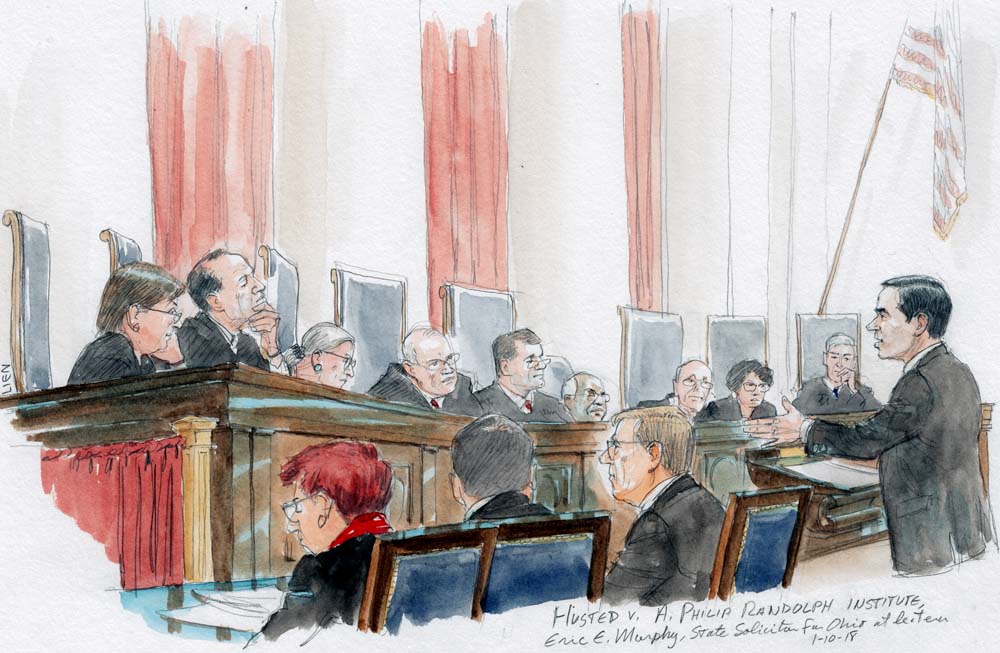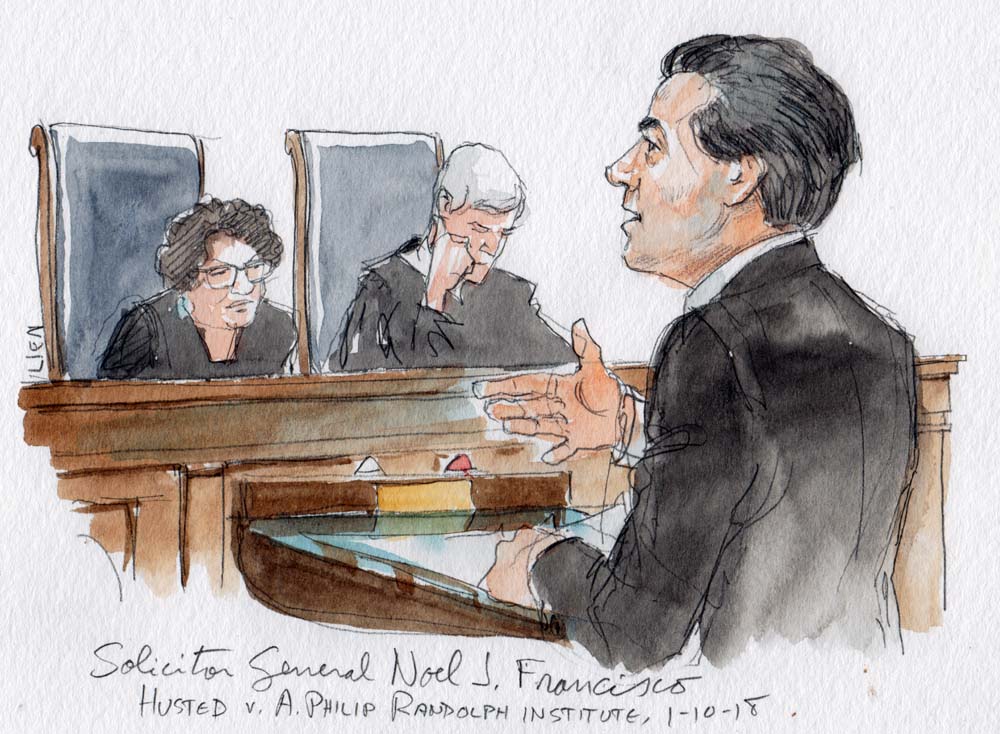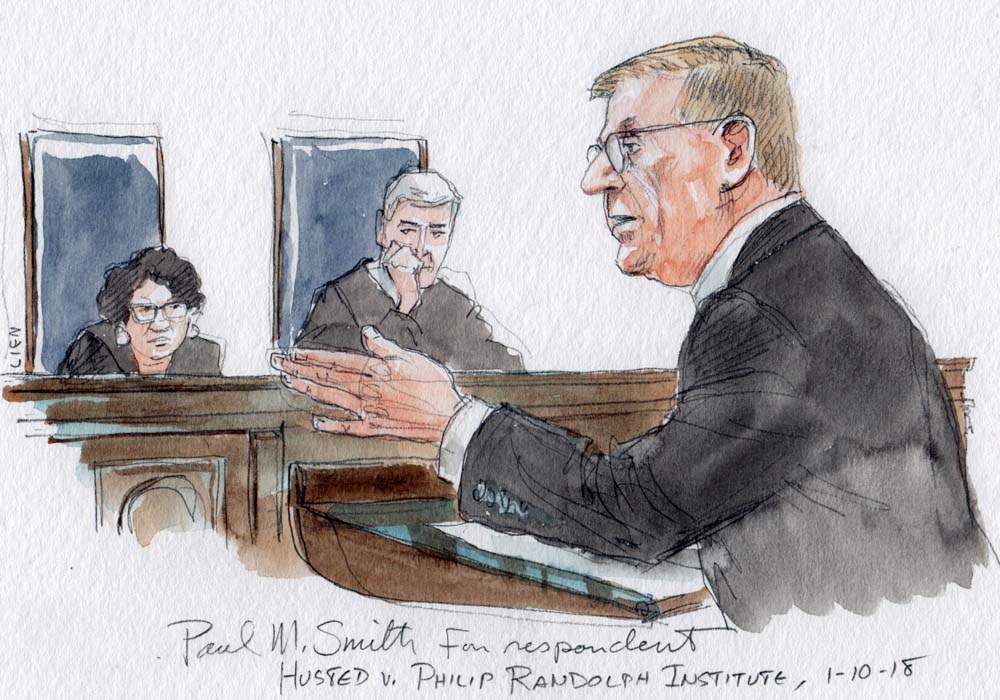Argument analysis: Ohio voter-registration practices safe?

on Jan 10, 2018 at 4:47 pm

The Supreme Court heard oral argument today in a challenge to a practice that Ohio uses to maintain its voter-registration lists. Under Ohio law, a voter who does not vote for two years is sent a notice, which asks him to confirm that he is still eligible to vote. If the voter does not return the notice and does not vote for the next four years, he is removed from the voter lists. The challengers argue that this practice violates federal law, which bars states from removing voters from their lists based on a failure to vote. Ohio counters that voters aren’t removed because they don’t vote; the removal only happens if they fail to respond to the notice that is mailed to them and then abstain from voting for four more years. Today the court’s more conservative justices seemed inclined to agree with the state – and could even pick up a sixth vote, from Justice Stephen Breyer.
Arguing on behalf of Ohio, state solicitor general Eric Murphy faced tough questions from some of the court’s more liberal justices. Justice Sonia Sotomayor focused on what she described as the “essence of this case.” Your position, she told Murphy, is that a failure to vote is enough evidence to suggest that someone has moved. But is that a reasonable conclusion to draw, she asked, when it has a disproportionate effect on areas with large groups of minorities, poor people and the homeless? These groups, she noted, tend to vote at lower rates than the rest of the population, “in large measure because many of them work long hours.” “How can we read this statute,” Sotomayor continued, “to permit you to begin a process of disenfranchising solely on the basis” of someone’s failure to vote, with no evidence that the voter has actually moved? “There are dozens of other ways” for the state to determine whether someone has moved, Sotomayor emphasized, ranging from the U.S. Postal Service to juror and driver changes of address. And I have to give the provision barring removal based on a failure to vote a meaning that avoids disenfranchising people, she concluded.

Eric E. Murphy, state solicitor for Ohio, at lectern arguing for petitioner (Art Lien)
Murphy again emphasized that the state’s practice passes muster because “no one is removed solely by reason of their failure to vote.” Justice Elena Kagan was perplexed by this argument, however. “Essentially what the Ohio program does,” she observed is rely on the failure to vote to trigger the notice; if a voter does not respond to the notice and again fails to vote, then he is removed from the rolls. Ohio, she told Murphy, was trying to “pick out the middle piece of that” – the failure to respond to the notice – and label it as the only cause of a voter’s removal, without giving any weight to the failure to vote. But that’s not how the law works, she suggested.
Justice Samuel Alito came to the state’s defense. Why isn’t the best interpretation of the law, he queried, “that one cannot be removed solely because of a failure to vote?” Murphy responded that Alito was “absolutely correct.”
Murphy was followed by Noel Francisco, the U.S. solicitor general, arguing on behalf of the federal government in support of Ohio. Francisco spent much of his time at the lectern parrying a volley of questions from Sotomayor about the federal government’s shift in position in this case. “There’s a 24-year history,” she observed, “of solicitors general” appointed by both Republican and Democratic presidents “who have taken a position contrary to yours.” It “seems quite unusual that your office would change its position so dramatically,” she said sternly. “How,” Sotomayor continued, “did the solicitor general change its mind? Do you believe this doesn’t have an impact, a negative impact on certain groups?”
Justice Ruth Bader Ginsburg entered the fray, asking Francisco (somewhat rhetorically) whether the federal government had previously agreed that a failure to vote “was not a reliable indicator” that someone had actually moved.
Francisco acknowledged that under the government’s prior position, a failure to vote was not regarded as “reliable evidence.” But, he added, under the government’s current reading of the law, there is no requirement that states have “reliable evidence” of a move.

Solicitor General Noel Francisco (Art Lien)
The topic of whether and how states can gather reliable evidence that someone has moved occupied much of the 30-plus minutes of oral argument for Paul Smith, who represented the challengers. Smith repeatedly told the justices that a voter’s failure to show up at the polls “simply does not provide adequate evidence that the person has moved at all.”
But Alito pushed back. In Ohio, he told Smith, failure to vote is not, standing alone, a ground for being removed from the voter lists. Instead, he posited, it is just evidence that someone may have moved out of the district.
In what could be an ominous sign for the challengers, Breyer seemed frustrated that states were left with what he seemed to regard as an impossible task. How, he asked Smith, are states supposed to track people who die or move out of state, to figure out whether they need to be removed from voter-registration lists? “We don’t want them on the voter roll,” Breyer declared. “That used to be a big problem, voting dead people.” He picked up this line of questioning again later on, telling Smith that he didn’t “believe Congress would have passed a statute that would prevent a state from purging a voting roll of people who have died or have moved out of the state.”
Kennedy repeated this sentiment, telling Smith that states were purging registration lists “to protect the voter rolls from people” who have moved and are “voting in the wrong district.”
Breyer later asked Smith whether a state could send out a card, labeled with instructions not to forward, to voters. If someone has moved, Breyer suggested, “and they wait long enough, and they send it a couple of times, the post office will send it back and then they’ll know the person has moved.”

Paul M. Smith for respondents (Art Lien)
Smith agreed that such a system would pass muster, leading to Breyer’s next question. In a lot of larger states, like California, Breyer said, it would be prohibitively expensive to send the non-forwardable cards to everyone. So what if the state instead decided to send the non-forwardable cards to people who “haven’t voted in three or four years”? Would that be a problem?
Smith responded that it would not be, as long as the state only removed people from lists when the cards were returned as undeliverable. In that scenario, he explained, the failure to vote would truly not be the trigger for removal, because the state would have “concrete, reliable evidence” that the voter had moved.
Roberts expressed surprise at Smith’s answer. Isn’t your whole argument, he asked, that Ohio’s practice violates federal law because it is triggered by the failure to vote? Smith tried to distinguish the two situations on the ground that under the current practice, the state does not have reliable information that someone has moved – it simply has the failure to respond to the notice, but it was not clear that Roberts was persuaded. He later returned to the topic, suggesting that Smith’s argument turns on the adequacy of the notice that the state provides to voters, rather than whether someone has shown up to vote.
Casting about for a solution, Breyer asked Smith whether there is any evidence in the record of this case about the significance of a voter’s failure to return a notice. The evidence shows, Smith responded, that most people throw such notices in the trash. It’s hard to say whether Smith’s answer was enough to satisfy Breyer’s concerns. Making this case harder still to handicap is that two of the court’s more conservative justices – Justices Clarence Thomas and Neil Gorsuch – asked no questions at all. But if Thomas and Gorsuch follow the direction in which Roberts, Kennedy and Alito appear to be heading, Breyer’s vote may not make a difference anyway. A decision in the case is expected by summer.
This post was originally published at Howe on the Court.


